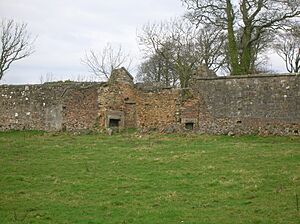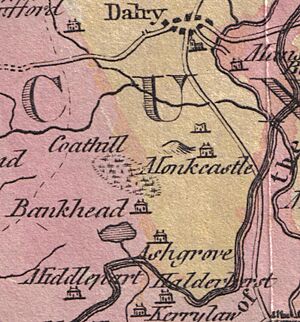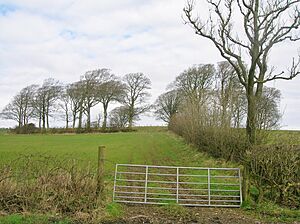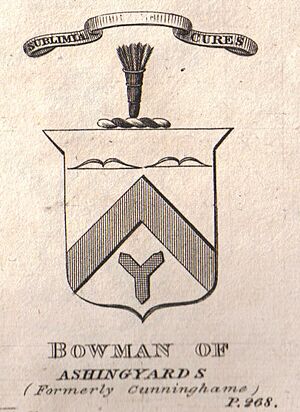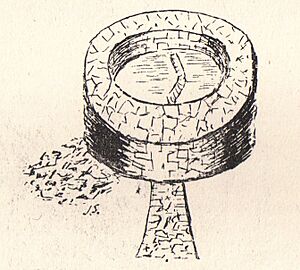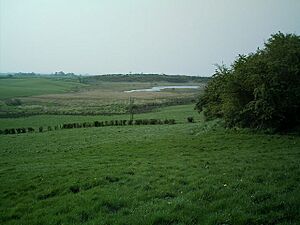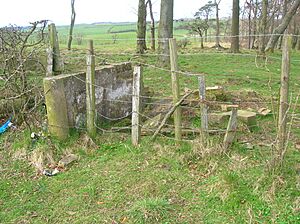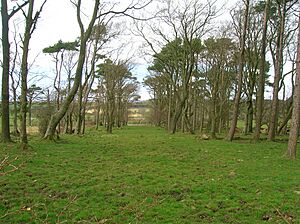The Lands of Ashgrove facts for kids
The Lands of Ashgrove, once called Ashenyards, was a small estate in Kilwinning, North Ayrshire, located between Kilwinning and Stevenston. The large house that stood there was taken down in 1960, but its big walled garden is still there today.
Contents
History of Ashgrove
The Kings' Road
Portencross Castle is believed to have been the last stop on the mainland for many old kings of Scotland. This was between the time of Kenneth I (810–858) and Malcolm III (1030/38-1093). The kings' coffins were carried by road from Edinburgh. They went through Kilwinning Abbey and then along what might have been an old Roman road to the harbors at Portencross. From there, they were put on a boat and taken to Iona, a sacred island where they were buried. People on pilgrimages also used this same route.
This special road, known as the 'Kings' Road', started at Kilwinning Abbey. It went through Byres and up through the Ashgrove lands. Then it took the 'Auld Clay Road' which branched off near Lochwood and went down towards Muirlaught Farm. Old maps from the 1700s show that the only direct road from Kilwinning to Portencross went this way. Today, much of this old road is no longer used or is only for farm vehicles. Some people think this road was built by the Romans.
The Ashgrove House and Garden
Ashgrove House was first built as offices, but it was later changed into a big, comfortable home. An older farm, Ashenyards or Ashinyards, was located to the east and looked over Ashgrove Loch. Nothing is left of that old farm now, but its ruins can be seen on old maps from the 1700s. It's not clear if Ashgrove House was built in a new spot or if it replaced the older farm. Both names were on maps in 1775.
A very large walled garden still stands at Ashgrove. Old maps show it used to be an orchard with paths, a sundial in the middle, and a greenhouse area. The main entrance had "white gates," as remembered by local people who walked along the lane to Whitehirst.
The Ashgrove Estate Lands
The Ashinyards lands, including its woods, covered about three to four hundred acres of good land. The large amount of woodland was a special feature of the estate. One area of trees is called the 'Short Ride Plantation', and another used to be known as the 'Long Ride Plantation'. Other areas like Quhytehirst (Whitehirst), Nether Mains, and Auchenkist were also once part of the estate. A small wooded hill called the Ashgrove Mount can still be found north of the walled garden.
Owners of Ashgrove Estate
The first recorded owner of Ashgrove was John Russel, who sold the lands in 1567 to James Cunninghame. James married Margaret Fleming and his son, Alexander, took over after him. Later, James Cunninghame, Alexander's brother, inherited the estate in 1627.
William Cunninghame of Ashinyards and Whitehurst is mentioned in 1664. He inherited the estate from his father James in 1671. In 1706, his only surviving daughter married Andrew Martin. Their son, Arthur Martin, moved to the West Indies and died there. His daughters, Margaret and Magdalene, sold the estate to John Bowman in 1766.
An old mapmaker named Pont recorded the owner as Alexander Cuninghame. He said the name 'Asshin-Zairds' came from 'Esch' (ash tree) and 'yaird' (a measure of land). This Cuninghame family was connected to the Earls of Glencairn. Andrew Martin bought the property in 1712 from William Cuninghame, his father-in-law. John Bowman bought Ashinyards when Andrew Martin's son was still young. John Bowman was also related to the Cuninghames.
The Cuninghame family owned Ashinyards from about 1570 until Elizabeth Cuninghame married John Bowman in 1695. John Bowman was a merchant from Glasgow and a chief leader in 1715. Their son, also named John Bowman, became a very important person in Glasgow. He married Miss Houghton in 1734 and they had two sons and two daughters. When he died in 1796, he left the estate to his oldest daughter, Anne. This was because his oldest son, John, moved to North America, and his second son, Houghton, moved to Dominica. John Bowman was the one who changed the name from Ashinyards to Ashgrove.
Anne Bowman married Miller Hill Hunt, a captain in the army who was hurt in the Battle of Culloden. Captain Hunt died in 1783, and Anne died in 1811. They had three daughters. Margaret inherited the estate in 1811 as the only surviving child. She changed her last name to Bowman, taking her grandfather's name and his family symbol. The Bowman family symbol (coat of arms) shows two bows and a quiver of arrows, which is a clever picture-pun on their name. Records show that family members were part of the Ancient Society of Kilwinning Archers.
Anne, also known as Lady Bowman, was followed by Andrew FitzJames Cuninghame Rollo-Bowman-Ballantyne. He was born in 1835 and was the son of Anne's sister, Elizabeth. Andrew married Anne Harriet Curzon Chalmers in 1864 and they had children. The Ballantine family still owned the property in the 1930s.
Ashgrove Loch and Wildlife
Ashgrove Loch, also known as Lochwood Loch or Stevenston Loch, is located west of Ashgrove. It is special because it's the only mineral-rich loch of its kind in North Ayrshire. A lot of the area around the loch has been drained by a deep ditch. Now, only about 10% of the loch is open water, with a floating mat of plants covering the rest.
On old maps, a "Loch Canal" is shown. This was a canal or stream from Stevenston Loch that went to a gate (sluice) at the north side of Lochend. It was called a canal because this part of the stream was cleaned every three years. The sluice used to control the water flow to Stevenston Mill.
The loch has been a special protected area for nature (Site of Special Scientific Interest) since 1975. Many interesting plants grow here, including greater bladderwort, lesser pond sedge, tufted loosestrife, and the very rare cowbane. Birds that breed here include snipe, water rail, grasshopper warbler, and reed bunting. The fields around Ashgrove Loch are full of wildlife. You can see flocks of chaffinch, reed bunting, yellowhammer, and tree sparrow there.
Ancient Island Homes (Crannogs)
Historian John Smith found up to six crannogs in Ashgrove Loch. A crannog is an old island home, usually made of wood. One crannog on the eastern side of Ashgrove Loch is special because it was mostly built from stone, not wood. It also had a path made of large sandstone blocks. Some people think this "crannog" might have actually been a dun, which is a type of old fort from the Middle Ages. Many old tools and items were found there, like chisels, wooden spoons, and bone tools.
There's a local story that the treasures from Kilwinning Abbey were hidden on a crannog in the loch by the monks. This happened when the abbey was attacked during the Reformation. It's interesting that the old 'Kings Road' to Portencross was very close to this site.
Interesting Facts About Ashgrove
In 1673, James Cunninghame was chosen to be the guardian for Sir William Cunninghame of Cunninghamhead.
John Bowman, who owned Ashgrove, bought the Montgreenan estate in 1778. However, he later sold it in 1794.
In 1851, the census records show that Margaret Ann Bowman, aged 78, owned the land and farmed about 130 acres. She had an agricultural worker, a dairymaid, and a housemaid working at Ashgrove.
There is a film from the 1930s that shows Ashgrove with a DeHavilland DH-60 Moth airplane on display. At that time, the Ballantine family still owned the property. Monica Ballantine, a family member, often landed her aircraft in the fields near the house.
Ashgrove House was left empty for many years and became a ruin before a local farmer took it down. There was also a forester's cottage on an estate lane. It was rebuilt as a bungalow in the 1930s but was later damaged and had to be demolished too.
An old farm building called Ashinyards was located on the hill. It was also taken down, and its stones were removed.
In the 1940s, the fields on the estate were mostly used to grow turnips and potatoes.
The monks from Kilwinning Abbey used to dig for coal near Ashgrove House a long time ago. Later, a mine in the area had to be closed because it flooded when the new tunnels dug into the old, flooded monk's workings.
Images for kids


